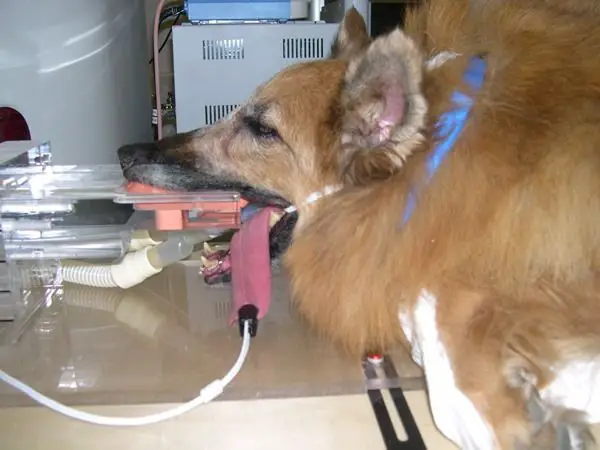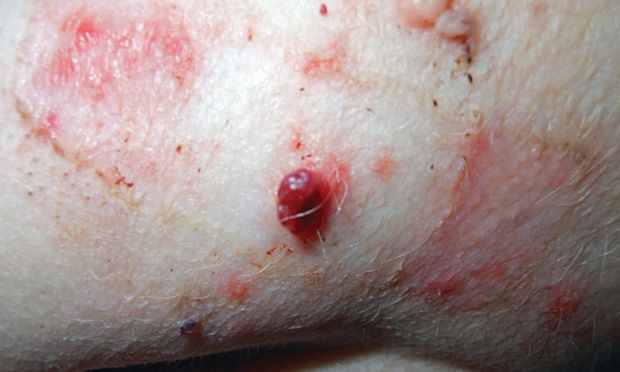Introduction
Radiation is energy that is emitted in the form of waves or particles. There are different types of radiation, including ionizing radiation from x-rays, gamma rays, and particle radiation, as well as non-ionizing radiation from radio waves, microwaves, and infrared light.
Dogs, like humans, can be affected by exposure to harmful radiation. When radioactive particles enter the body, they can damage cells and DNA, potentially causing illness. The effects of radiation depend on the radiation dose, as well as the duration of exposure.
This article will provide an overview of the different types of radiation, the potential risks and health effects for dogs, recommended exposure limits, and ways to protect dogs from radiation. The goal is to inform dog owners about this important health topic.
Types of Radiation Exposure

Dogs can be exposed to different types of radiation, both naturally occurring and man-made. Some of the main types of radiation exposure in dogs include:
Medical radiation – Dogs receiving radiation therapy for cancer treatment are directly exposed to ionizing radiation from x-rays or particle beam sources. Radiation doses are carefully controlled but side effects can occur (Spatola, 2021).
Nuclear accidents – Accidents at nuclear power plants or nuclear testing sites can release radioactive particles over a wide area. Dogs in the vicinity can inhale or ingest radionuclides or be exposed externally (CDC, 2022). The 1986 Chernobyl disaster exposed many animals to radiation.
Dirty bombs – Radiological weapons or dirty bombs are designed to spread radioactive material through conventional explosives. This could potentially expose dogs to dangerous radioactive isotopes (Hooser, 2018).
Medical imaging – While not treated directly, dogs present during their owner’s radiation treatments like CT scans or nuclear medicine procedures can be exposed to scattered radiation. Exposure levels are usually very low.
Background radiation – Low levels of naturally occurring cosmic, terrestrial and internal radiation exist everywhere. Higher background levels can occur in certain geographic areas.
Effects of Radiation
Radiation can damage cells and DNA in the body. According to the CDC, ionizing radiation deposits enough energy into cells and tissues to cause damage by removing electrons from atoms, creating charged ions (1). There are two primary ways that radiation exposure can affect health:
Acute effects occur shortly after exposure to high doses of radiation. These include skin burns, acute radiation syndrome (ARS), and radiation poisoning. ARS involves symptoms like nausea, vomiting, headache, and diarrhea. Without treatment, high radiation doses can be fatal (1).
Chronic effects can show up months or years after exposure. These include cancer and other diseases related to damage to DNA and cells. Ionizing radiation has enough energy to break chemical bonds in DNA, causing mutations that can lead to cancer (2). Other chronic effects include cataracts, cardiovascular disease, and harm to the immune system, lungs, and kidneys (1).
Children and fetuses are especially sensitive to radiation damage. Exposure while in the womb can affect brain development and increase cancer risk later in life (2). Overall, radiation damages cells’ ability to grow and divide properly. While low doses have less effect, there is no threshold below which radiation is harmless (1).
Sources:
(1) https://www.cdc.gov/nceh/radiation/health.html
(2) https://www.epa.gov/radiation/radiation-health-effects
Radiation Risks
Radiation exposure poses several risks to dogs, both in the short term and long term. According to research, frequent effects of radiation exposure in dogs include haematological changes, infertility, and cancer of the bone, liver, lung, and blood (NCBI, 2021)[1]. Specific risks include:

Burns – Radiation can damage the skin and lymphatic vessels, causing red, sunburn-like patches, bald patches, skin color changes, and fluid buildup under the skin (RMCV Colorado, 2022)[2]. This is especially common in areas where radiation is beamed at tumors.
Organ damage – Radiation can damage the salivary glands, digestive tract, and urinary bladder, leading to side effects like mouth sores, nausea, vomiting, diarrhea, and blood in the urine. It can also damage bone marrow, which produces blood cells (Vet Specialty, n.d.)[3].
Cancer – Ionizing radiation is a known carcinogen. Dogs receiving radiation therapy have an increased lifelong risk of developing secondary cancers in the radiation field or nearby areas (NCBI, 2021)[1].
Infertility – Radiation to the pelvic region can damage ovaries, testicles, and sex organs. This can lead to temporary or permanent infertility in dogs (NCBI, 2021)[1].
Brain effects – Radiation to the head can cause side effects like dullness, behavior changes, seizures, and blindness if the optic nerve is damaged (Vet Specialty, n.d.)[3].
Death – High, acute doses of radiation exposure can damage critical organs and bone marrow to the point of being fatal within days or weeks (NCBI, 2021)[1].
[1] https://www.ncbi.nlm.nih.gov/pmc/articles/PMC8429057/
[2] https://www.rmvccolorado.com/site/blog/2022/10/15/side-effects-of-radiation-therapy-for-dogs
[3] https://www.vetspecialty.com/specialties/medical-and-radiation-oncology/radiation-therapy-side-effects/
Radiation Sensitivity
Dogs tend to be more sensitive to radiation compared to humans. One study found that canine B-cell lymphoma cells were more radiosensitive than human B-cell lymphoma cells (Maeda et al., 2016). Factors that influence radiation sensitivity in dogs include breed, age, and health status.
Small dog breeds tend to be more sensitive to radiation than larger breeds. This is likely due to their smaller body size and faster metabolic rate (Spatola, 2021). Puppies and senior dogs also tend to be more radiosensitive than adult dogs.
Dogs with compromised immune systems or existing health conditions may experience greater radiation effects. The sensitivity depends on the type and dose of radiation as well as individual variability. However, evidence suggests dogs overall tolerate radiation less effectively compared to humans.
Protecting Dogs from Radiation
There are several steps pet owners can take to minimize radiation exposure for dogs:
Keep dogs indoors as much as possible if radiation levels outside are elevated. Close windows and doors and limit time spent outdoors.
Give dogs potassium iodide tablets if recommended by a veterinarian. This can help protect the thyroid gland from radioactive iodine exposure (Source).

Feed dogs food and treats containing kelp or dulce to maintain proper iodine levels. This can help block radioactive iodine from being absorbed (Source).
Wipe dogs’ paws, fur, and ears with a damp cloth if they go outside in contaminated areas. Monitor them closely and do not let them lick the fur before cleaning (Source).
Seek veterinary care immediately if a dog displays symptoms like skin burns, vomiting, or diarrhea after radiation exposure. Treatment may include medications, IV fluids, and supportive care.
Radiation Exposure Limits
There are some safety limits for dog radiation exposure that have been set by veterinary groups. According to the American College of Veterinary Radiology, the maximum permissible dose for occupational exposure in veterinary medicine is 5 rem (50 mSv) per year. They recommend occupational exposure for veterinary staff be kept below 0.5 rem (5 mSv) per year.
For radiation therapy treatments, dosage limits depend on the area being treated. According to one study, the maximum activity administered to a dog was 1.59 GBq for radiosynoviorthesis treatment of arthritis (Wendt, 2020). Experts emphasize the importance of minimizing exposure to non-target areas during radiation therapy.
Overall, there are not firmly established annual dose limits for pet radiation exposure. However, experts agree doses should be kept as low as reasonably achievable (ALARA). Following occupational exposure limits for veterinary staff can help guide safe practices.
Case Studies
One of the most well-known examples of dogs affected by radiation exposure is from the Chernobyl nuclear disaster in 1986. When the Chernobyl reactor melted down, it released large amounts of radioactive material into the surrounding area. Many residents were evacuated, but dogs and other animals were left behind.

Researchers have been studying the dogs living around the Chernobyl exclusion zone to understand the effects of chronic radiation exposure. A 2023 study published in Science Advances analyzed the genetics of 162 dogs and wolves in the Chernobyl area and found evidence of adaptation and natural selection in response to radiation exposure over multiple generations. The research provides new insights into the effects of low-dose radiation exposure over a long period of time (https://www.science.org/doi/10.1126/sciadv.ade2537).
The dogs living in the Chernobyl exclusion zone today are the descendants of pets left behind after the disaster. They live in the wild and have adapted to the high radiation levels. While many dogs in the years immediately after Chernobyl showed clear signs of radiation sickness and died early, the dogs today have better survival rates, possibly due to genetic adaptations over multiple generations.
FAQs
Can dogs get cancer from radiation?
Yes, dogs can develop cancer from radiation exposure, just like humans. The most common radiation-induced cancers in dogs include lymphoma, leukemia, bone cancer, and skin cancer. The risk depends on the amount and duration of radiation exposure. Dogs treated with radiation therapy for an existing cancer are at higher risk of developing a second cancer later in life due to that therapeutic radiation exposure. [Source]
How long do the side effects of radiation last in dogs?
The acute side effects of radiation therapy in dogs, like redness, irritation, hair loss, and fatigue, usually resolve within 4-6 weeks after treatment ends. However, some side effects like skin discoloration may be permanent. Late side effects, like damaged salivary glands, may develop months or years later. With palliative radiation, side effects are usually minimal. [Source]
Can radiation poisoning in dogs be treated?
There is no direct treatment for radiation poisoning in dogs. Supportive veterinary care focuses on minimizing damage and managing symptoms. This may include anti-nausea medication, intravenous fluids, blood transfusions, antibiotics, and treatment for burns or skin lesions from high radiation exposure. The prognosis depends on the radiation dose and how quickly it was detected and treated. [Source]
Conclusion
In summary, radiation exposure can pose significant health risks to dogs if proper precautions are not taken. Ionizing radiation like x-rays and gamma rays can damage cells and DNA, potentially leading to cancer and other diseases. Even small doses over time can accumulate and cause harm.
Dogs are more sensitive to radiation than humans due to their faster cell turnover. Higher doses can cause radiation poisoning with symptoms like hair loss, skin burns, vomiting, and bleeding. Puppies and pregnant dogs are especially vulnerable.
To protect your dog, avoid unnecessary radiological exams, use lead shielding during x-rays, and limit time spent in contaminated areas. Keep dogs indoors after nuclear accidents and don’t exercise them in radioactive environments. Consult your vet if you suspect radiation illness.
While radiation should be treated with caution, reasonable precautions can greatly reduce a dog’s exposure. With some common sense, dog owners can keep their pets safe and healthy even in radiated environments.